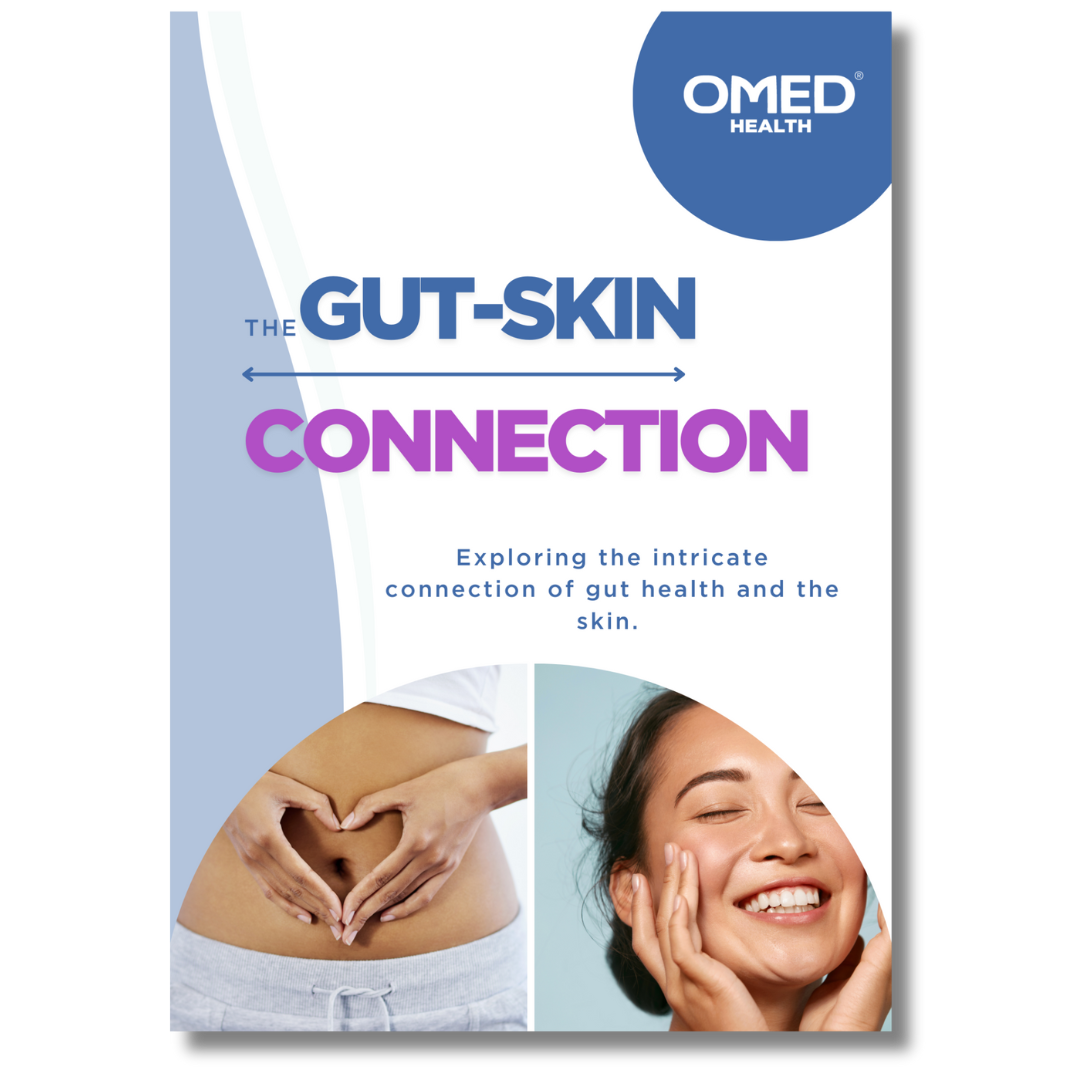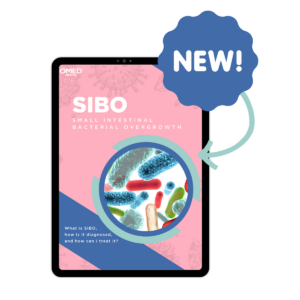You may have heard of the gut microbiome – the community of microbes living in our intestines that play a key role in our health and wellness. When the microbiome gets out of balance (known as dysbiosis) it is thought to contribute to various health issues, including inflammatory bowel disease (IBD) (1), liver disease (2), and even certain types of cancer (3).
Dysbiosis of the microbiome can also impact our skin health and contribute to conditions such as eczema, psoriasis, and acne (4). This means that taking care of your gut health isn’t just about digestion, it’s about supporting the immune system and keeping our skin healthy, and looking good.
What is Rosacea?
Rosacea is a skin condition that causes redness and a rash on the face. It is more common in women, however, men seem to experience more severe symptoms. Rosacea is an inflammatory condition and can present itself in many ways, including flushing, red or purple skin, and pus-filled spots. The condition can show up differently in every person and can be caused by a mix of factors both inside and outside the body.
These include genetics, UV light, heat, immune system imbalances, and changes in the balance of bacteria in the gut (5). Interestingly, and the key point of this blog is, that many people with rosacea also experience digestive issues like bloating and stomach pain. It is suspected that there might be a connection between skin health and the gut microbiome, which could explain these symptoms.
There are many gases found in exhaled breath such as hydrogen and methane that are believed to come from the activity of the gut microbiome, offering an interesting way to explore the connection between gut health and skin issues like rosacea. To dig deeper, a study investigated whether there is a connection between small intestinal bacterial overgrowth (SIBO) and rosacea (6).
This study used breath tests to measure levels of the key gases hydrogen and methane, alongside checking for gut symptoms and examining the skin. The goal was to find out how common SIBO is in people with rosacea and if treating SIBO could improve rosacea symptoms.
Let’s delve into this study…
In this study, 113 people with rosacea and 60 healthy people were included, and they all had their blood, stool, and breath tested. They also had the severity of rosacea assessed and answered questions about their symptoms (stomach pain, bloating, diarrhea, etc). The breath tests specifically measured hydrogen and methane, which are commonly measured to diagnose patients with SIBO.
Some of those who tested positive for SIBO based on the hydrogen and methane in their breath were randomly picked to receive rifaximin – an antibiotic used for the treatment of SIBO. After treatment, patients took another breath test to see if their SIBO was cleared and had their symptoms and rosacea assessed again.
But what were the results?
SIBO is more common in people with rosacea.
52 patients with rosacea were found to also have SIBO, whereas only 3 patients without rosacea had the condition. SIBO was successfully treated in 28 (87.5%) of patients who took rifaximin, and in these people, their gut symptoms were also improved. Of these patients, 26 also found improvements in their rosacea.
The findings from this study suggest a potential connection between imbalances in the gut microbiome and the development of rosacea. People with rosacea were more likely to have SIBO compared to those without rosacea. Treating SIBO improved the skin symptoms associated with rosacea, with many patients maintaining these improvements for several months.
The exact reason for this link is not fully understood, but it is believed that SIBO may cause the gut to become more permeable, meaning the immune system and inflammatory compounds can leave the gut and circulate throughout the body, potentially triggering skin inflammation in people prone to rosacea. In fact, studies have found that people with SIBO often have higher levels of inflammatory compounds in their blood, which could contribute to rosacea (7).
Rifaximin is an antibiotic that stays in the gut and doesn’t affect other areas of the body. This helps ensure that the improvements seen in rosacea symptoms in the patients with SIBO and rosacea who took the medication are likely due to the treatment targeting the gut bacteria rather the the skin.
Breath analysis and OMED Health.
This study demonstrates the power of breath analysis to provide information about the activity of the gut microbiome through hydrogen and methane gases. The levels of these gases in the breath can be used to diagnose conditions such as SIBO that may have important roles in diseases of the skin like rosacea.
If you are living with uncomfortable digestive symptoms, taking a simple at-home breath test can help identify whether you have SIBO, and therefore allow for the appropriate treatment for SIBO. Find out how you can purchase a hydrogen and methane breath test from OMED Health.
We recognize the significance of empowering individuals to gain insight into their gut health, allowing them to regain control over their digestive health. To address this, we have developed the OMED Health Breath Analyzer and App, set to launch soon. This at-home breath testing device and paired app is an innovative solution that enables the monitoring of hydrogen and methane levels in your breath alongside the tracking of relevant lifestyle factors that may contribute to your discomfort.
By interpreting this data with the expertise of our network of experts, patients can access personalized treatment plans and ongoing monitoring, enabling them to make well-informed decisions about their gut health. Secure your priority access by joining the waitlist today.
References.
- Frank DN, St. Amand AL, Feldman RA, Boedeker EC, Harpaz N, Pace NR. Molecular-phylogenetic characterization of microbial community imbalances in human inflammatory bowel diseases. Proc Natl Acad Sci U S A. 2007 Aug 21;104(34):13780–5. DOI: 10.1073/pnas.0706625104
- Zhu L, Baker SS, Gill C, Liu W, Alkhouri R, Baker RD, et al. Characterization of gut microbiomes in nonalcoholic steatohepatitis (NASH) patients: A connection between endogenous alcohol and NASH. Hepatology. 2013;57(2):601–9. DOI: 10.1002/hep.26093
- Louis P, Hold GL, Flint HJ. The gut microbiota, bacterial metabolites and colorectal cancer. Nat Rev Microbiol. 2014 Oct;12(10):661–72. DOI: 10.1038/nrmicro3344
- De Pessemier B, Grine L, Debaere M, Maes A, Paetzold B, Callewaert C. Gut–Skin Axis: Current Knowledge of the Interrelationship between Microbial Dysbiosis and Skin Conditions. Microorganisms. 2021 Feb;9(2):353. DOI: 10.3390/microorganisms9020353
- Rainer BM, Kang S, Chien AL. Rosacea: Epidemiology, pathogenesis, and treatment. Dermatoendocrinol. 2017 Jan 1;9(1):e1361574. DOI: 10.1080/19381980.2017.1361574
- Parodi A, Paolino S, Greco A, Drago F, Mansi C, Rebora A, et al. Small Intestinal Bacterial Overgrowth in Rosacea: Clinical Effectiveness of Its Eradication. Clin Gastroenterol Hepatol. 2008 Jul 1;6(7):759–64. DOI: 10.1016/j.cgh.2008.02.054
- Sánchez-Pellicer P, Eguren-Michelena C, García-Gavín J, Llamas-Velasco M, Navarro-Moratalla L, Núñez-Delegido E, et al. Rosacea, microbiome and probiotics: the gut-skin axis. Front Microbiol. 2024 Jan 8;14:1323644. DOI: 10.3389/fmicb.2023.1323644


